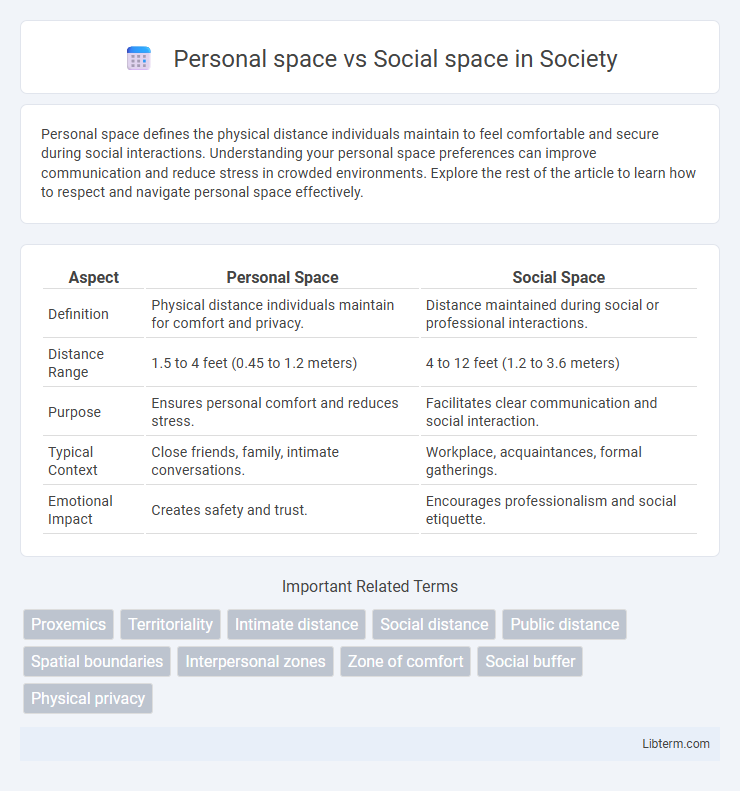Personal space defines the physical distance individuals maintain to feel comfortable and secure during social interactions. Understanding your personal space preferences can improve communication and reduce stress in crowded environments. Explore the rest of the article to learn how to respect and navigate personal space effectively.
Table of Comparison
| Aspect | Personal Space | Social Space |
|---|---|---|
| Definition | Physical distance individuals maintain for comfort and privacy. | Distance maintained during social or professional interactions. |
| Distance Range | 1.5 to 4 feet (0.45 to 1.2 meters) | 4 to 12 feet (1.2 to 3.6 meters) |
| Purpose | Ensures personal comfort and reduces stress. | Facilitates clear communication and social interaction. |
| Typical Context | Close friends, family, intimate conversations. | Workplace, acquaintances, formal gatherings. |
| Emotional Impact | Creates safety and trust. | Encourages professionalism and social etiquette. |
Defining Personal Space
Personal space refers to the invisible boundary individuals maintain around themselves to feel comfortable and secure, typically ranging from 1.5 to 4 feet in social settings. This zone varies by culture, context, and relationship, influencing how people perceive proximity and intimacy during interactions. Understanding the distinction between personal space and social space, which extends from 4 to 12 feet, is crucial for effective communication and respecting social norms.
Understanding Social Space
Social space refers to the physical distance maintained between individuals during social interactions, typically ranging from 4 to 12 feet depending on cultural norms and context. Understanding social space involves recognizing how proximity influences communication, comfort levels, and relationship dynamics in environments like workplaces, public settings, and social gatherings. Effective management of social space enhances interpersonal rapport, reduces discomfort, and supports appropriate social behavior across diverse cultural contexts.
Key Differences between Personal and Social Space
Personal space typically ranges from 1.5 to 4 feet and is reserved for close relationships, providing comfort and a sense of security. Social space extends from about 4 to 12 feet, used for interactions among acquaintances or in professional settings, balancing openness with privacy. Understanding these distance zones is crucial for effective communication and respecting social boundaries.
Cultural Influences on Spatial Boundaries
Cultural influences significantly shape personal space and social space norms, dictating acceptable physical distances in interpersonal interactions. For instance, Latin American and Middle Eastern cultures often tolerate closer proximity, while Northern European and East Asian cultures prefer more expansive spatial boundaries. These cultural variations impact communication styles, social comfort, and perceptions of respect or intrusion in social and personal contexts.
Psychological Significance of Personal Space
Personal space serves as a crucial psychological boundary that individuals maintain to feel safe and secure, influencing emotional well-being and stress levels. Violations of personal space can trigger anxiety, discomfort, or aggression, reflecting its role in nonverbal communication and social interaction. Understanding the distinction between personal space and social space is essential in contexts like therapy, workplace design, and public settings to promote positive psychological outcomes.
Social Space in Group Dynamics
Social space in group dynamics refers to the physical and psychological distance maintained between individuals during interactions, shaping communication patterns and group cohesion. This space influences nonverbal cues, such as body language and eye contact, which regulate turn-taking and signal group roles or status. Understanding social space enables more effective collaboration by fostering comfort, reducing conflicts, and enhancing mutual respect within team environments.
How Technology Impacts Personal and Social Spaces
Technology blurs the boundaries between personal space and social space by enabling constant connectivity through smartphones, social media, and virtual platforms, often reducing physical privacy and altering face-to-face interactions. Digital communication tools expand social space but can invade personal space by transmitting notifications and messages anytime, causing stress and distraction. Smart home devices and wearable technology further integrate into personal environments, reshaping how individuals manage their privacy and social engagement in daily life.
Respecting Space in Professional Environments
Respecting personal space in professional environments fosters trust and effective communication by acknowledging individual boundaries typically ranging from 18 inches to 4 feet. Social space, extending from 4 to 12 feet, is appropriate for formal interactions, ensuring comfort and professionalism. Awareness of these spatial zones enhances workplace etiquette and reduces potential discomfort or misunderstandings during meetings and collaborative tasks.
Personal Space Violations: Causes and Effects
Personal space violations occur when individuals feel their physical boundaries are intruded upon, often leading to discomfort, anxiety, and stress. Common causes include cultural differences, lack of spatial awareness, and crowded environments, which disrupt the psychological sense of safety. These violations can impair communication, increase aggression, and reduce overall wellbeing by triggering defensive behaviors and emotional distress.
Tips for Navigating Personal and Social Space in Daily Life
Respecting personal space involves maintaining an optimal distance of about 18 inches to 4 feet to ensure comfort and avoid intrusiveness. In social spaces, such as parties or meetings, staying within 4 to 12 feet fosters effective communication while respecting social norms. Observing body language cues and adjusting proximity accordingly helps navigate these spaces harmoniously in daily interactions.
Personal space Infographic

 libterm.com
libterm.com